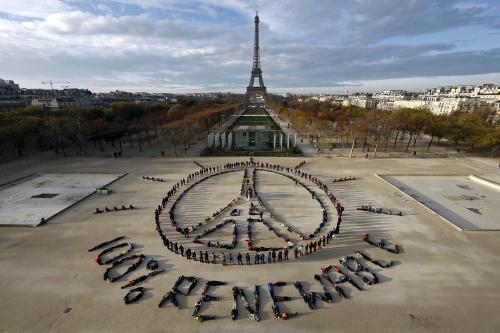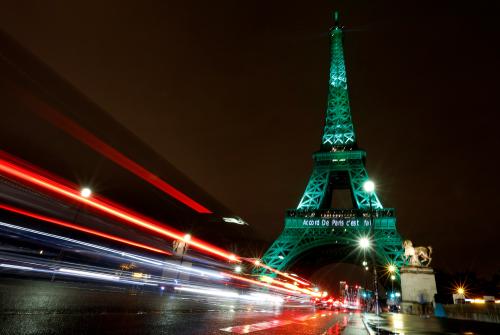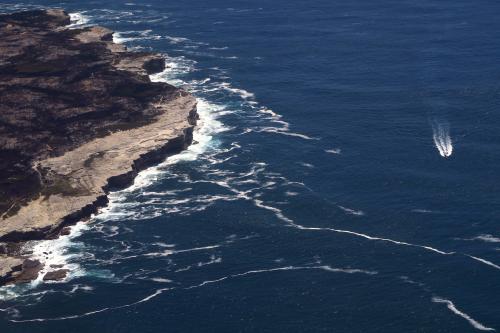This week, the world’s wealthy nations published a document to explain to the rest of the world how they would meet a climate action promise made in 2009 at the contentious Copenhagen climate change conference. When they made the promise the negotiations were faltering, and pressure from the developing nations for the rich countries to pay for dealing with the climate problem they’d created was intense.
In the midst of the turmoil, Hillary Clinton, then secretary of state at President Barack Obama’s side, reportedly came up with a bold number: $100 billion a year that rich countries would deliver by 2020 to help developing nations cope with the rising impacts of climate change and to move to lower carbon economies. In the final negotiations the wording of the promise became more guarded, but the number stuck, and now we are just three years away from the deadline. The pressure has not abated.
The blank white cover of the new document proclaims only its title: “Roadmap to $100 Billion.” That the roadmap is a political document is clear from the outset: the first page reports that “The Roadmap aims to build confidence and provide increased predictability and transparency about the actions developed countries are and will be taking to achieve the $100 billion goal.”
Developing nations and non-governmental organizations (NGOs) have been calling for such a roadmap for years, but its timing now is the result of language won by developing states in the Paris Decision text that “strongly urges developed country Parties to scale up their level of financial support, with a concrete roadmap to achieve the goal of jointly providing $100 billion annually by 2020 for mitigation and adaptation while significantly increasing adaptation finance from current levels and to further provide appropriate technology and capacity-building support” (Paragraph 114).
The roadmap therefore is a positive document with a welcome message but that nonetheless has important areas lacking clarity and concern.
Perhaps most importantly, the roadmap document puts down four priority areas in climate finance. They are:
- Scaling-up public resources
- Significantly increasing finance for adaptation
- Using public finance and policy interventions to effectively mobilize private finance
- Supporting enhanced access, capacity building, and investment readiness
If these are indeed what will result from this document, this is a major milestone on the road. This list could have been written by delegations of the Least Developed Countries, Small Island Developing States, and the leading NGOs and research institutions working for developing country interests—are nearly their precise talking points of what was lacking in the past six years of climate finance delivery. The roadmap therefore is a positive document with a welcome message but that nonetheless has important areas lacking clarity and concern. We take up some of the major ones here.
How much is being delivered?
The newly minted roadmap claims that countries are well on their way to meeting the $100 billion goal, and describes how multilateral development banks (MDBs) are filling much of the void. We agree that MDBs are making very significant efforts on climate that are moving the needle on North-South finance flows, but the roadmap fails to clarify how OECD governments are actually going to meet the $100 billion goal.
Figure 1: Projected finance levels in 2020

Source: OECD (2016)
The document also makes clear that these are just projections, based on a number of assumptions, and a “scenario” approach is taken, rather than last year’s report, which made claims of actual amounts delivered. The blowback from that report might explain the change of tone and approach this time.
More careful this time
Our observation is that the roadmap is significantly more careful than last year’s OECD-CPI report, and this gives the document more credibility. Rather than projecting upward from the 2014 numbers, the roadmap uses an average of the 2013 and 2014 numbers to describe current levels of public funding committed. It only uses stated promises of future funding by nations. It describes efforts to avoid double-counting. It admits that the 2015 report faced “data gaps and methodological limitations [that] meant the picture it presented was necessarily partial.” And most importantly, it reports that “Developed countries are looking forward to working with all Parties to continue to improve the tracking of climate finance in the context of our work to build an enhanced transparency framework under the Paris Agreement.” This is a supportive statement for the SBSTA’s (the “Subsidiary Body for Scientific and Technological Advice”, an arm of the UNFCCC) efforts to develop “modalities of accounting” for climate finance, a key task for the next two years.
We agree that multilateral development banks are really stepping up on climate finance. The Inter-American Development Bank pledged to double climate finance to 30 percent of its operational approvals by 2020. The World Bank (which currently provides approximately $10.3 billion of climate finance per year) announced that it will grow its climate work by a third to 28 percent of annual commitments by 2020. We also appreciate that the roadmap only included existing export credits, and did not project their ramping up. This is an interesting choice, perhaps an admission that providing support to corporations from the global North to sell their products to the South was not at all what the developing nations had in mind when they heard the $100 billion pledge back in Copenhagen. As a result of these steps toward greater caution, the roadmap authors proclaim that “the projection should be considered a conservative, indicative aggregation of public climate finance levels in 2020, rather than a firm prediction.” However the lack of clarity on where the data is coming from is in many ways worse than last year’s report.
Underlying data at question
Last year’s OECD-CPI report made some strong claims about how much money was being delivered by the OECD countries for climate, and was strongly critiqued, including by the government of India. To give an idea of the dueling claims, the OECD-CPI report claimed $62 billion was delivered in 2014, while India said only $2.2 billion could rigorously be defended as meeting the promise from Copenhagen. We concluded last year that many flows counted by the OECD should not in fact have been counted, such as market-based loans counted at the full amounts, and export credits. Our own AdaptationWatch.org study released last fall suggested that many of the numbers underlying the OECD’s claims are based on questionable data coming from their member states. We found that perhaps three-quarters of the projects counted as helping developing countries adapt to climate change in fact do not stand up to rigorous criteria in this regard. Further, the OECD-CPI report itself showed just how differently the way countries count these projects should give pause to anyone planning to sum up national efforts to say a collective pledge is being met.
We agree that MDBs are making very significant efforts on climate that are moving the needle on North-South finance flows, but the roadmap fails to clarify how OECD governments are actually going to meet the $100 billion goal.
The roadmap claims that “the UNFCCC Standing Committee on Finance’s forthcoming 2016 Biennial Assessment reports similar levels of aggregate climate finance from developed to developing countries”—but these are solely aggregations of developed countries own claims, not independent reassessments. The Standing Committee on Finance itself has been harshly critical of contributor country data on climate finance and of existing categorization and data systems, so there is no evidence that the quality of the underlying data has been improved from the report released last year.
Open questions
A series of open questions leave one to conclude that the roadmap is a political document with some positive contributions but which should be taken with more than a grain of salt. We’ll take up four just to wrap this up. First, the document reports that “In preparing the Roadmap, we have consulted with developing country Parties and groups … as well as non-government organizations and experts.” However, this statement is ambiguous and without any details—who was consulted and how? Were methods adjusted based on this input?
Second, the roadmap rightly points to the need for a sharp increase in public funding for adaptation. A doubling is suggested in the roadmap, which would be a valuable start, but groups like Oxfam are calling for a quadrupling. This would still not bring adaptation to “balance” with mitigation spending, as was agreed in Copenhagen and reiterated in Paris. Indeed adaptation spending is very hard to track and adaptation projects tend to be much smaller than mitigation ones. However relying upon the Green Climate Fund’s allocating 50 percent to adaptation will not get us far toward any meaningful level of funding in this area. Current Green Climate Fund spending is on the order of just $2.5 billion per year, so half of that is just 2-4 percent of total funding. And as just mentioned, our study suggests that only one quarter of what’s been counted as adaptation will stand up to more rigorous accounting.
Third, the OECD-CPI report (2015) stated that “For increased transparency, in addition to total public finance, the group intends to provide information on public budgetary sources and/or grant equivalent in future reporting.” However, the roadmap does not provide any figures on grant equivalent basis. Counting loans at face value—the current practice of most developed countries—makes contributors supplying loans as have massive portfolios, compared to those countries providing grants. Worse, perhaps, is that the repayment of the loans does not currently count against the amounts of North-South flows.
Fourth, the absolutely fundamental issue of whether all this funding is not just being siphoned off from development assistance so desperately needed by developing countries is nowhere made clear in the roadmap. There is no statement on how developed countries are going to “share the burden” of helping developing nations. And there’s not a word about how they are going to make sure that the most vulnerable countries are going to receive help. In particular, there is nothing in the roadmap about addressing those dark places on the map where no assistance is flowing, countries that might be called “Climate Finance Orphans.” For a roadmap, the document oddly lacks any information about geographic allocation and potential gaps.
A series of open questions leave one to conclude that the roadmap is a political document with some positive contributions but which should be taken with more than a grain of salt.
In the end, this roadmap makes the nice point that the goal here is not just about meeting the fateful Copenhagen pledge, but achieving the Paris objectives, which are that “developed country Parties shall provide financial resources to assist developing country Parties with respect to both mitigation and adaptation in continuation of their existing obligations under the Convention” (Paris Agreement, Article 9.1).
We hope the signatory nations are sincere on what’s said in the roadmap. The $100 billion promise will only be valuable if it builds trust and helps create resilient, low-carbon societies in the developing world.
The Brookings Institution is committed to quality, independence, and impact.
We are supported by a diverse array of funders. In line with our values and policies, each Brookings publication represents the sole views of its author(s).








Commentary
Roadmap to Where? Is the ‘$100 billion by 2020’ pledge from Copenhagen still realistic?
October 20, 2016